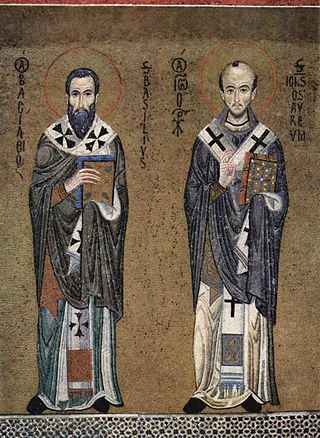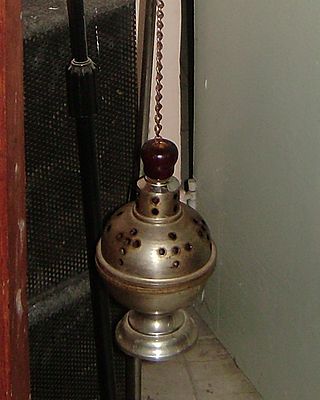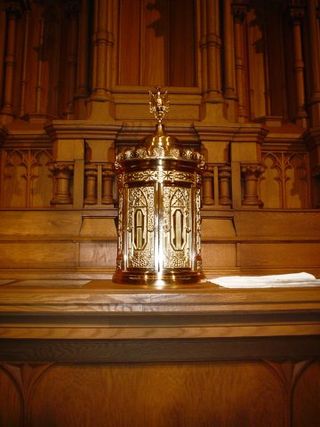
An altar is a table or platform for the presentation of religious offerings, for sacrifices, or for other ritualistic purposes. Altars are found at shrines, temples, churches, and other places of worship. They are used particularly in paganism, Christianity, Buddhism, Hinduism, Judaism, modern paganism, and in certain Islamic communities around Caucasia and Asia Minor. Many historical-medieval faiths also made use of them, including the Roman, Greek, and Norse religions.

The Tridentine Mass, also known as the Traditional Latin Mass or the Traditional Rite, is the liturgy in the Roman Missal of the Catholic Church codified in 1570 and published thereafter with amendments up to 1962. Celebrated almost exclusively in Ecclesiastical Latin, it was the most widely used Eucharistic liturgy in the world from its issuance in 1570 until the introduction of the Mass of Paul VI.
Subdeacon is a minor order or ministry for men in various branches of Christianity. The subdeacon has a specific liturgical role and is placed between the acolyte and the deacon in the order of precedence.

Divine Liturgy or Holy Liturgy is the Eucharistic service of the Byzantine Rite, a liturgical rite developed from the Antiochene Rite of Christian liturgy which is that of the Ecumenical Patriarchate of Constantinople. As such, it is used in the Eastern Orthodox, the Greek Catholic Churches, and the Ukrainian Lutheran Church. Although the same term is sometimes applied in English to the Eucharistic service of Armenian Christians, both of the Armenian Apostolic Church and of the Armenian Catholic Church, they use in their own language a term meaning "holy offering" or "holy sacrifice". Other churches also treat "Divine Liturgy" simply as one of many names that can be used, but it is not their normal term.

An altar server is a lay assistant to a member of the clergy during a Christian liturgy. An altar server attends to supporting tasks at the altar such as fetching and carrying, ringing the altar bell, helping bring up the gifts, and bringing up the liturgical books, among other things. If young, the server is commonly called an altar boy or altar girl. In some Christian denominations, altar servers are known as acolytes.

A thurible is a metal censer suspended from chains, in which incense is burned during worship services. It is used in Christian churches including the Roman Catholic, Eastern Orthodox, Assyrian Church of the East and Oriental Orthodox, as well as in some Lutheran, Old Catholic, United Methodist, Reformed, Presbyterian Church USA, and Anglican churches. In Roman Catholic, Lutheran, and Anglican churches, the altar server who carries the thurible is called the thurifer. The practice is rooted in the earlier traditions of Judaism in the time of the Second Jewish Temple.

Genuflection or genuflexion is the act of bending a knee to the ground, as distinguished from kneeling which more strictly involves both knees. From early times, it has been a gesture of deep respect for a superior. Today, the gesture is common in the Christian religious practices of the Anglicanism, Lutheranism, the Catholic Church, and Western Rite Orthodoxy. The Latin word genuflectio, from which the English word is derived, originally meant kneeling with both knees rather than the rapid dropping to one knee and immediately rising that became customary in Western Europe in the Middle Ages. It is often referred to as "going down on one knee" or "bowing the knee". In Western culture, one genuflects on the left knee to a human dignitary, whether ecclesiastical or civil, while, in Christian churches and chapels, one genuflects on the right knee when the Sacrament is not exposed but in a tabernacle or veiled.

A tabernacle or a sacrament house is a fixed, locked box in which the Eucharist is stored as part of the "reserved sacrament" rite. A container for the same purpose, which is set directly into a wall, is called an aumbry.

The Roman Rite is the most common ritual family for performing the ecclesiastical services of the Latin Church, the largest of the sui iuris particular churches that comprise the Catholic Church. The Roman Rite governs rites such as the Roman Mass and the Liturgy of the Hours as well as the manner in which sacraments and blessings are performed.

An altar cloth is used in the Christian liturgy to cover the altar. It serves as a sign of reverence as well as a decoration and a protection of the altar and the sacred vessels. In the orthodox churches it is covered by the antimension, which also contains the relics of saints.

Solemn Mass is the full ceremonial form of a Mass, predominantly associated with the Tridentine Mass where it is celebrated by a priest with a deacon and a subdeacon, requiring most of the parts of the Mass to be sung, and the use of incense. It is also called High Mass or Solemn High Mass.

A Christian burial is the burial of a deceased person with specifically Christian rites; typically, in consecrated ground. Until recent times Christians generally objected to cremation because it interfered with the concept of the resurrection of a corpse, and practiced inhumation almost exclusively. Today this opposition has all but vanished among Protestants and Catholics alike, and this is rapidly becoming more common, although Eastern Orthodox Churches still mostly forbid cremation.
The Canon of the Mass, also known as the Canon of the Roman Mass and in the Mass of Paul VI as the Roman Canon or Eucharistic Prayer I, is the oldest anaphora used in the Roman Rite of Mass. The name Canon Missæ was used in the Tridentine Missal from the first typical edition of Pope Pius V in 1570 to that of Pope John XXIII in 1962 to describe the part of the Mass of the Roman Rite that began after the Sanctus with the words Te igitur. All editions preceding that of 1962 place the indication "Canon Missae" at the head of each page from that point until the end of the Mass; that of 1962 does so only until the page preceding the Pater Noster and places the heading "Ordo Missae" on the following pages.
The Roman Canon is the oldest eucharistic prayer used in the Mass of the Roman Rite, and dates its arrangement to at least the 7th century; its core, however, is much older. Through the centuries, the Roman Canon has undergone minor alterations and modifications, but retains the same essential form it took in the seventh century under Pope Gregory I. Before 1970, it was the only eucharistic prayer used in the Roman Missal, but since then three other eucharistic prayers were newly composed for the Mass of Paul VI.
The text and rubrics of the Roman Canon have undergone revisions over the centuries, while the canon itself has retained its essential form as arranged no later than the 7th century. The rubrics, as is customary in similar liturgical books, indicate the manner in which to carry out the celebration.

The Mass is the central liturgical service of the Eucharist in the Catholic Church, in which bread and wine are consecrated and become the body and blood of Christ. As defined by the Church at the Council of Trent, in the Mass "the same Christ who offered himself once in a bloody manner on the altar of the cross, is present and offered in an unbloody manner". The Church describes the Mass as the "source and summit of the Christian life", and teaches that the Mass is a sacrifice, in which the sacramental bread and wine, through consecration by an ordained priest, become the sacrificial body, blood, soul, and divinity of Christ as the sacrifice on Calvary made truly present once again on the altar. The Catholic Church permits only baptised members in the state of grace to receive Christ in the Eucharist.
Eastern Orthodox worship in this article is distinguished from Eastern Orthodox prayer in that 'worship' refers to the activity of the Christian Church as a body offering up prayers to God while 'prayer' refers to the individual devotional traditions of the Orthodox.
Orate fratres is the incipit of a request for prayer that the priest celebrating Mass of the Roman Rite addresses to the faithful participating in it before saying the Prayer over the Offerings, formerly called the Secret. It thus corresponds to the Oremus said before the Collect and the Postcommunion, and is an expansion of those shorter exhortations. It has gone through several alterations since the Middle Ages.

The liturgical books of the Roman Rite are the official books containing the words to be recited and the actions to be performed in the celebration of Catholic liturgy as done in Rome. The Roman Rite of the Latin or Western Church of the Catholic Church is the most widely celebrated of the scores of Catholic liturgical rites. The titles of some of these books contain the adjective "Roman", e.g. the "Roman Missal", to distinguish them from the liturgical books for the other rites of the Church.

The altar in the Catholic Church is used for celebrating the Sacrifice of the Mass.















